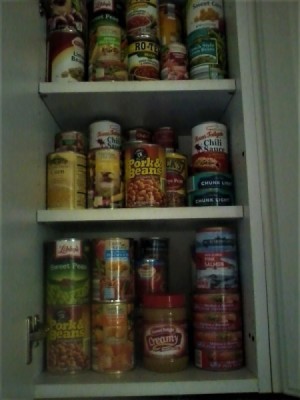
 I used to think that frugal living centered around clipping coupons and buying items on sale. I have come to realize that frugal living is a lifestyle that can be developed by adopting specific money-saving habits. Based on my experience, practicing good organizational skills plays a significant role in the development of a frugal lifestyle. Getting and staying organized can be the foundation upon which the many other frugal living habits such as simplifying, scheduling and budgeting, can be successfully implemented.
I used to think that frugal living centered around clipping coupons and buying items on sale. I have come to realize that frugal living is a lifestyle that can be developed by adopting specific money-saving habits. Based on my experience, practicing good organizational skills plays a significant role in the development of a frugal lifestyle. Getting and staying organized can be the foundation upon which the many other frugal living habits such as simplifying, scheduling and budgeting, can be successfully implemented.
A frugal lifestyle focuses on saving money. Disorganization can result in spending money unnecessarily. If your closets, cabinets, and drawers are stuffed and cluttered, you may find yourself buying items that you already had but had forgotten about or simply couldn't find. When items get pushed to the back of a disorganized refrigerator, they may spoil before you find them again. Food waste is not conducive to frugal living. If disorganization is a personal habit, you might find yourself missing appointments because you forgot to put them on your calendar. If fees are applied to those missed appointments, you've once again wasted money unnecessarily.
Not only does disorganization cost you financially, it can take up time that could have been spent in a more profitable or enjoyable way. You can waste a lot of time searching for keys, phones, homework and other essentials when they get lost among the clutter. You can prepare a grocery list, using weekly sale ads and coupons, much faster if your pantry and refrigerator are organized. Youll be able to see at a glance what you need. You can plan your meals according to the items you have on hand and their expiration dates. Once you experience the benefits organization provides, youll see how well it fits into your frugal lifestyle.
Organizational habits support a frugal lifestyle in many ways. As you organize your home, youll probably discover you have items taking up space that you havent used in a long time and very likely will not need in the future. Reduce your clutter by donating those items. In the future, when youre tempted to make impulsive purchases remember how many of those previous impulse buys were a waste of money and a contributor to your clutter. A simple lifestyle is complementary to a frugal lifestyle. Clearing the clutter and organizing your possessions can give you a greater sense of appreciation for simple living. It can also motivate you to be more reserved in your spending. When you focus on buying what you need instead of things you want or things that are trendy, you will find it easier to stay within a budget.
Setting up a schedule to perform home maintenance tasks such as changing furnace filters, vacuuming around and under appliances, checking for leaks under the sink and in the basement and doing a visual inspection of the exterior of your home can help prevent an expensive repair. Typically, its easier to budget in a service check on your heating and cooling system than to wait until you need a major repair. The same concept applies to repairing gutters, the roof or addressing small plumbing problems before they become big problems. Taking time to prepare a detailed budget is always a good way to save money. Seeing where your money goes and finding ways to reduce expenses is one of the most important aspects of a frugal lifestyle.
There are many benefits to adopting a frugal lifestyle. First, there are the money saving benefit which can reduce the stress that comes with trying to live paycheck to paycheck. Pairing frugality with simplicity can free up some of your time. That time can be used for personal relaxation, family activities or to participate in free or nearly free community events. Living a frugal lifestyle gives you opportunities to expand your creativity and increase your appreciation for simplicity.
Add your voice! Click below to comment. ThriftyFun is powered by your wisdom!
Very true! We had all our paper plates, cups and cutlery in bags on the floor of a closet. I finally organized and was unpleasantly surprised to find out that I had more plastic cutlery than I will ever be able to use. We just kept buying because we didn't want to dig through the bags.
I recently lost my hubby who held on to everything and now I find myself downsizing to an apartment and not my 1500 square foot home of 36 years. I could not believe the things I bought with plans to use in the future. Being the queen of procrastination, most of these items were never used or spoiled in the fridge/freezer.
To manage clothing, I have developed the "Rule of 6." If you have access to a washer and dryer, you really don't need more than 6 of each type of clothing. For example, 6 tees, 6 long sleeved shirts, 6 work outfits, 6 pairs of trousers, 6 sets of underwear, etc. Those in colder climates will want a couple of hoodies or sweaters, a couple of sets of sets of mittens/gloves, hats, and scarves, a raincoat, and warm winter coat.
My church has a free clothes closet where people donate good clothing , that maybe doesn't fit anymore, or you might be tired of. don't like the color etc. . .then they open the doors every other month, people can go in and pick out whatever they want or need. This really saves on the clothing budget. especially if you have children in the family.
I consider myself an organized pack rat, while my husband is a cluttery pack rat. My son is the king of all pack rats, but that's his wife's problem now.
Several years ago, I decided to stop buying anything except groceries and necessary items of clothing. At a certain age, trendy clothing no longer appeals to a lot of us. Since my wardrobe is jeans, t-shirts, and shorts in the summer, I only replace things that are worn out. (I do wear nice pants and tops to church.)
I've cut off pants to make shorts when a hole develops in the knee area. I've flipped collars on my husband's nice dress shirts.
When I needed something, I shopped in my own house. (My husband and son never miss anything I might take from their multiple stashes.) I stopped buying craft supplies, and focused on finally finishing all the craft projects I'd bought on sale after Christmas for years. For example, I'd bought Christmas tapestry blocks, (originally $4 each, on sale for 25 to 50 cents) though I wasn't sure what I'd do with them. My husband had a plaid table runner from a stained glass booth he used to have, so I sewed the four blocks on it, evenly spaced, and that's what I hang above my piano every year.
I love going into my sewing room and coming out with something useful that I made from fabric scraps. When towels get worn around the edges, I cut them in either 4 or 6 pieces and sew bias binding (made from scraps, of course) to make "designer" hand towels or wash cloths.
I went through my scraps a few years ago and made reversible purses that my friend sold at a craft bazaar. When my husband's colorful shirts get too worn, I use the fabric for a number of things. Spending the morning in my sewing room, listening to music I like, is like therapy to me.
This last week, I needed a plastic pan to put under our A/C unit, and figured a litter pan would work. The metal pan rusts, and replacing it was expensive several years ago, so I started using one I found in the garage (never used for cats). It was getting brittle and starting to crack, so I was planning on buying a new one, and then I remembered the little plastic pan I got in the hospital a couple of years ago. I wasn't using it for anything else, so it's in the attic now. The pan at the store would have cost $6.99.
Thanks for sharing. I needed this reminder! I have found myself caught in this very thing. I find disorganization to be a habit whether formed by ourselves because I feel a little lazy or because it was an environment I grew up in. It takes an effort to make things work, and with the effort also the organization which for some of is the biggest part of the effort.
Add your voice! Click below to comment. ThriftyFun is powered by your wisdom!